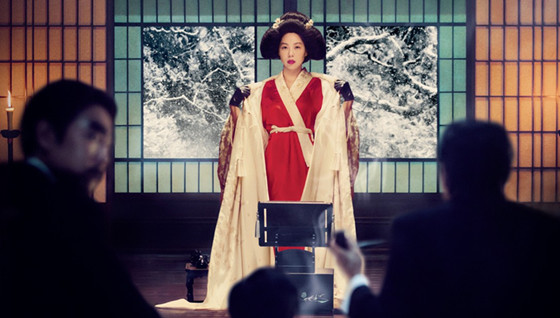5. Cinematically gorgeous

Chung Chung-hoon’s cinematography provides great images, both in in the bucolic exterior of the mansion and the interior, with the S&M scenes in the literature club being the most impressive and abnormally original. The wide framing is excellent, and, in that fashion, many stills look like actual paintings, and occasionally, they actually are.
The attention to detail is extraordinary, either in the shots of Kouzuki’s treasured book collection or in the paintings Lady Hideko and Fujiwara draw or in the various calligraphic writings on scrolls and books. The same applies to the exterior shots with the ones in the rain and the full moon standing apart.
The cinematography also works on another level, as what is actually occurring in the story is not presented through actions or words, but through the protagonists’ facial expressions, in a film where nothing as it seems to be. In that aspect also, Chung Chung-hoon succeeds to the fullest.
6. Imposing set design

Starting from the house’s interior, designer Ryu Seong-hee did a magnificent job in combining Japanese simplicity with the hyperbole of the baroque style, in a maximalist amalgam that is stylish, as much as it is grotesque, particularly in the lower levels of the house.
Furthermore, the interior of the house seems to change constantly, according to the segment of the story and the person who narrates, retaining, though, its distinct style. In that fashion, it actually functions as a living entity, as it seems to present more rooms, corridors, and viewpoints as time passes. Additionally, it actually mirrors the general aesthetics of the film, where nothing is as it seems.
7. Great editing

Park Chan-wook used an unusual narration style, in order to stay close to the actual structure of the book. Thus, the film is split in three segments, with the first and the third telling the story from Sook-hee’s perspective, and the second one from Lady Hideko’s. In that fashion, he used much narration, and even narration within the narration, which is presented as the thoughts of the person that tells the story each time.
His efforts were successful, particularly due to Kim Jae-bum’s and Kim Sang-beom’s editing, that kept the complex narration easy to understand, despite the fact that new events and perspectives are added in each segment.
Particularly the various crosscut sequences are masterfully edited, as are the explosions of the color green that occur each time the action is transferred outside the mansion.
8. Elaborate combination of art-house, mainstream, and exploitation/cult

One of the reasons Park Chan-wook is so popular among audiences of different genres is that he manages to combine elements from the three largest film categories.
The art-house part is presented through the elaborateness in the technical department and particularly the cinematography and the set design. The long shots of the bucolic exterior of the mansion, the close shots of the interior, the moments without speech (although not many), the crosscuts, and the close ups on the characters’ eyes are all elements usually associated with art-house films. The same applies on the emphasis on detail, which occasionally touches the borders of OCD, that is chiefly evident in the interior of the estate.
The mainstream element derives from the romance between a lady and a criminal in the story, the lesbian sex scenes, which are steamy as much as lengthy, the cast, which mainly consists of very popular actors, the various plot twists, and the theme of revenge, one of the most popular among S. Korean audience. The intense music that accompanies all the significant scenes also moves towards the same, mainstream direction.
The exploitation/cult element is somewhat toned down in comparison with Park’s previous works, with the sole exception of “I am a Cyborg, but that’s OK”. However, it is once more quite intense, and exemplified by the concept of the underground, erotic literature club, the abnormal eroticism that seems to emit from all its members, and the scene of torture, which is quite graphic.
The concept of Kouzuki’s character is also a part of the cult element, both in appearance and actual persona. Lastly, the appearance of a giant octopus in an aquarium in the basement is reminiscent of one of the most cult moments in Park’s filmography, the scene where Dae-su is eating living octopi in “Oldboy.”
9. Messages presented through extremity

Through the extremity of the story, Park manages to present a number of social messages, once more. Trust is one of the most central, in its antithetic forms, the first being retaining it and the second losing it. Vulnerability, which can become a flaw or a weapon, depending on the circumstances.
The fact that being rich can actually lead to some kind of imprisonment, with the only solution towards freedom being to leave it all behind. The effort people take sometimes in order to present a facade more appropriate to their status and their circumstances. The virtues of patience and intelligence that have to be injected with perception and cunning in order to flourish.
Lastly, the crookedness of the world of the extremely rich, which is filled with crookedness and perversion, even more than the actual crime world.
Author Bio: Panos Kotzathanasis is a film critic who focuses on the cinema of East Asia. He enjoys films from all genres, although he is a big fan of exploitation. You can follow him on Facebook or Twitter.